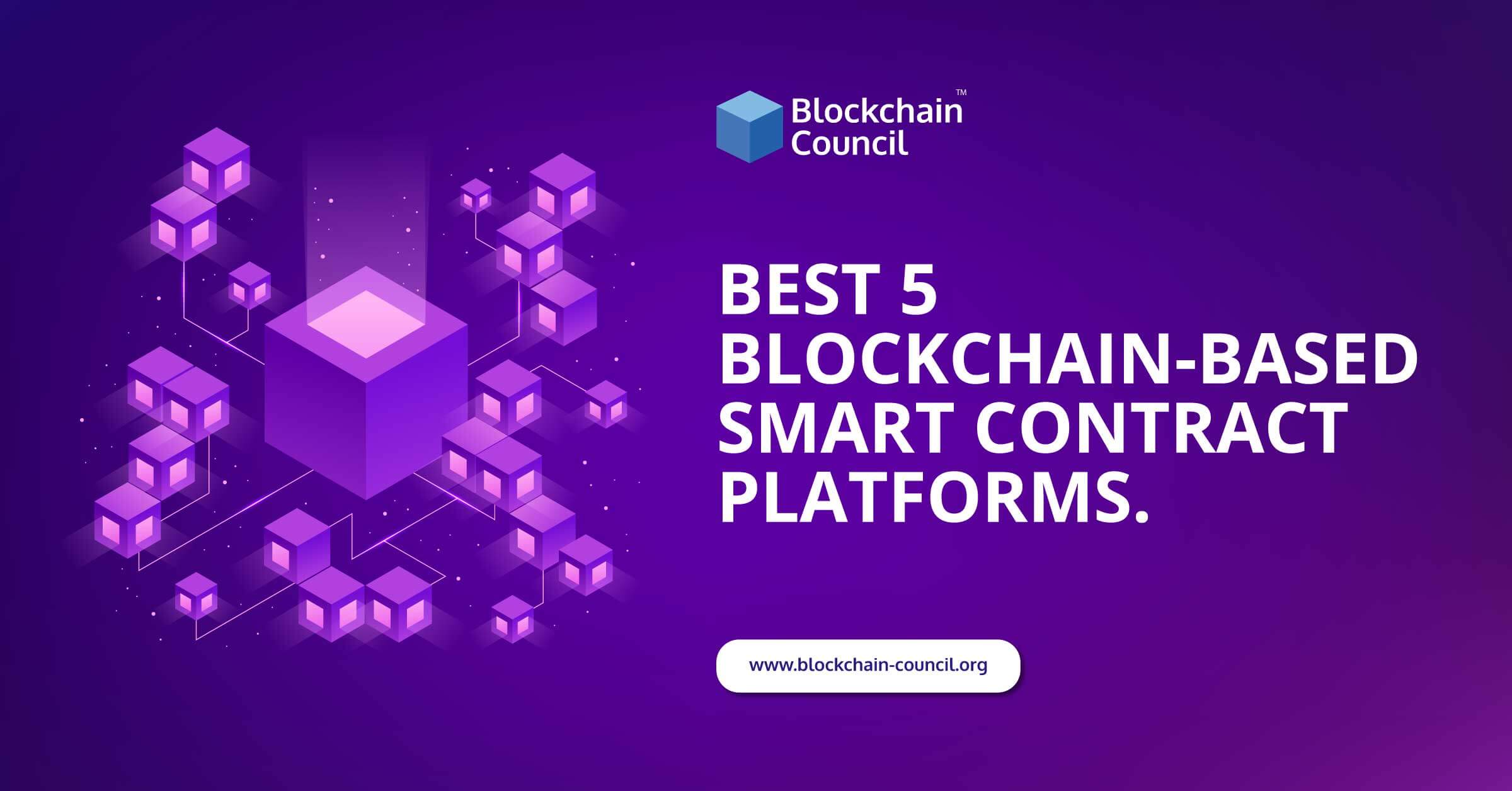
- Toshendra Kumar Sharma
- October 26, 2023
Summary
- Smart contracts in Blockchain are self-executing agreements written in code on a decentralized network.
- They eliminate the need for intermediaries and offer transparency, irreversibility, and traceability.
- The article highlights the top 5 Blockchain-based smart contract platforms.
- Hyperledger Fabric is an open-source, modular framework with support from The Linux Foundation.
- Ethereum is known for versatile smart contracts and a large, active community.
- NEM offers safety, scalability, and ease of use with Java.
- Stellar executes smart contracts directly on its network, emphasizing simplicity.
- Waves focuses on speed, scalability, and has its unique Ride programming language.
- The choice of platform depends on specific needs and objectives.
Think of a vending machine. All of us are familiar with the vending machine, which is found almost everywhere. This is a simple yet effective smart contract example to understand how it works. You make your choice in the machine, put in the money, and outcomes your milkshake. Instead of this, if you had gone to a regular store, you would need to interact with the cashier. This applies to all the valuable exchanges which happen in our life. If you need a document or an agreement to be prepared, in real life, you will have to take the services of a lawyer, pay them a fee, and get the document from them.
But this is not the case with Blockchain smart contracts. In a traditional contract, there are agreements, rules, and penalties. But in a smart contract, the penalties are automatically meted out to the defaulters. As there are several Blockchains that offer the feature of smart contracts, it might be confusing to identify the best one, especially if you are new to the world of Blockchain.
In this article we will help you choose the best smart contract in Blockchain. Irrespective of whether you are a beginner or an advanced learner, this article will prove to be useful to you as it will throw light on the current top 5 Blockchain-based smart contract platforms.
Understanding Smart Contracts
So, what exactly is a smart contract in Blockchain ?It refers to a self-executing contract where the terms of the agreement between the buyer and the seller are directly written into lines of code. The code and the agreements contained therein exist over a distributed, decentralized Blockchain network. Smart contracts allow for trusted transactions and agreements to be carried out among anonymous parties without the need for a central entity, external enforcement mechanism, or legal system. This way, the transactions are transparent, irreversible, and traceable. Implementing smart contracts in Blockchains is made possible through Solidity, the high-level object-oriented programming language.
American computer scientist Nick Szabo was the first to propose the concept of smart contracts in 1994. He invented a virtual currency called ‘Bit Gold’ in 1998, ten years before the invention of the Bitcoin by Satoshi Nakamoto, the anonymous inventor of Bitcoin. Szabo is even rumored to be the real Satoshi Nakamoto, which he has denied. Szabo defined smart contracts as computerized transaction protocols executing the terms of the contract.
What Smart Contracts Can Do
| Function | Description |
| Manage agreements between users | Smart contracts can enforce and execute agreements or contracts automatically without intermediaries. |
| Multi-signature accounts | They can require multiple approvals for fund spending, ensuring security and trust. |
| Provide utility to other contracts | Smart contracts can be used as building blocks for more complex applications and contracts. |
| Store application information | They can store data related to applications, like membership records or domain registration info. |
- Manage agreements between users: Smart contracts act like digital agreements. When two or more parties enter into a contract, the smart contract ensures that the terms of the agreement are followed automatically. For example, in a rental agreement, the smart contract can release the security deposit to the landlord once the tenant has left the property in good condition.
- Multi-signature accounts: Think of this like a group decision. In some cases, you might want several people to agree before money can be spent. Smart contracts can be set up to require, let’s say, 3 out of 5 people to approve a transaction before it happens. This adds an extra layer of security and trust, like when multiple people need to sign off on an important decision.
- Provide utility to other contracts: Smart contracts are like building blocks. They can be used to create more complex systems. For instance, you can have one smart contract that handles voting and another that manages funds. These can work together to create a voting system where funds are released based on the vote results.
- Store application information: Smart contracts can store data. Imagine a smart contract for a club membership. It can keep a list of all the members and their renewal dates. Or, for domain registration, it can hold records of who owns a domain and when it expires.
Also Read- How Smart Contracts Are Changing The Way We Do Business?
Best 5 smart contract platforms
Let us now take a deeper look at the Blockchain platforms which are best-suited for designing smart contracts. This will help you understand what sets them apart.
1. Hyperledger Fabric
Hyperledger is an open-source, global collaboration that is hosted by The Linux Foundation. Using this, one can create and develop enterprise-grade, distributed ledger frameworks to support business transactions. It was launched in 2016 with a technical and organizational governance structure and comprises 30 founding corporate members. It makes use of a modular approach to build Blockchains, and this helps companies develop what works best for them. It has attracted big companies such as J.P.Morgan, IBM, Intel, and Samsung. More than software, Hyperledger is a project framework.
Hyperledger Fabric is hosted under the umbrella of The Linux Foundation. It is a Blockchain framework that aids in developing applications or solutions with a modular architecture. It supports the plug-and-play version of membership services and consensus. It leverages container technology known as ‘chaincode’ to host smart contracts. Hyperledger Fabric has proved itself as an outstanding smart contract platform and as a feasible option. With a community of over 120,000 contributing organizations and more than 15,000 engineers, it’s a collaborative effort that stands as a behemoth in the Blockchain landscape.
It is co-developed by IBM, and since it is a permissioned Blockchain, it is possible to execute smart contracts or chain codes using hyperledger fabric. It means that all the identities of all the participants of the network will be known. This is perfect for companies aspiring to create smart contracts. But they have to adhere to data protection laws. Like in Ethereum, hyperledger developers use a set of helpful tools which include Hyperledger Composer, tools based on javascript, that helps developers create smart contracts conveniently. Blockchain developers can use javascript, Go, and other common programming languages too for developing smart contracts. This makes hyperledger more flexible.
Key Features:
- Open Source Foundation: Hyperledger Fabric enjoys the support of The Linux Foundation and boasts an active developer community. It’s not tied to a single vendor, ensuring sustainability and versatility for your projects.
- Permissioned Network: Privacy and trust are non-negotiable in certain industries. Fabric’s permissioned network ensures that only authenticated and authorized participants can access and contribute to the Blockchain. This makes it an ideal choice when data security is paramount.
- Governance and Access Control: Fabric offers fine-grained control over data access through private channels and transaction subsets. This feature is particularly valuable when you’re sharing a network with competitors or entities that require limited data exposure.
- Superior Performance: Tailored for enterprise use, Hyperledger Fabric can efficiently handle rapid transaction throughput thanks to its consensus mechanism. It doesn’t suffer from the performance issues related to Byzantine Fault Tolerance that some other Blockchain platforms face.
- Modular Ecosystem: The modular structure of Hyperledger Fabric simplifies customization and component integration. You can save time and effort by leveraging existing features and easily incorporating new modules, ensuring that your Blockchain network aligns precisely with your needs.
2. Ethereum
Ethereum isn’t limited to handling cryptocurrency. It is a versatile platform catering to a myriad of needs. As the first platform to support smart contracts, Ethereum has fostered a culture of innovation. Here developers continuously push the boundaries of what’s possible.
Ethereum provides a decentralized machine called the Ethereum Virtual Machine (EVM) which executes scripts using an international network of public nodes. The ethereum community is regarded as the largest and most active Blockchain community across the globe. It includes app developers, core protocol developers, mining organizations, Fortune 500 companies, ordinary users, etc. The beauty of Ethereum smart contracts lies in the support and standardization it offers.
Developing smart contracts in Ethereum is easy and less risky as the rules a developer needs to adhere to are clearly published. Though Ethereum has the biggest market capitalization among all the smart contract platforms, it is investing more to improve the development and operation of smart contracts. For this purpose, it has built Solidity, its own smart contract programming language. In spite of some security issues and bugs in its code, Ethereum smart contracts are widely regarded as the best choice for developers.
So what makes Ethereum one of the best Blockchain-based smart contract platforms? Let’s find out!
Key Features:
- Versatile Smart Contracts: Ethereum is not limited to basic transactions. Its “Turing-complete” scripting language allows developers to create smart contracts that can perform a wide range of tasks, from managing financial agreements to handling supply chains and even facilitating voting systems. If you can imagine it, Ethereum can probably do it.
- Market Dominance: Ethereum isn’t just another player in the field; it’s the second-largest cryptocurrency by market capitalization, just trailing behind Bitcoin. As of October 19, 2023, it boasts a market cap of over $170 billion. This dominance means it has the resources and community backing to support long-term growth and stability.
- Ongoing Evolution (Ethereum 2.0): Ethereum never stands still. It’s currently undergoing a major upgrade to Ethereum 2.0, which promises scalability, security, and sustainability improvements. This is a clear sign of Ethereum’s commitment to staying at the forefront of Blockchain technology.
- Industry Giants Trust It: When big names like Microsoft, JPMorgan Chase, and ConsenSys embrace a technology, you know it’s doing something right. These industry giants have recognized Ethereum’s potential and are actively using it in various capacities.
- Decentralized Apps (dApps) Galore: Ethereum boasts the largest ecosystem of decentralized applications (dApps) globally. With over 4,400 dApps built on Ethereum, including popular ones like Uniswap, Aave, and OpenSea, it’s evident that Ethereum is the go-to platform for developers looking to bring their innovative ideas to life.
3. NEM
NEM refers to a peer-to-peer cryptocurrency and Blockchain platform that was launched on 31 March 2015. It has now become the first choice of many developers as it is written using java, which is one of the widely used programming languages in the world. It is easily accessible, and it is not mandatory for developers to learn a platform-specific programming language like Solidity. As per experts, the recently launched Catapult or Mijin v.2 update by NEM renders it as the safest smart contract platform across the globe. It is highly scalable. While Ethereum can process 15 transactions per second, NEM manages to process 100. These features make NEM the best choice for developers.
Key Features:
- Proof-of-Importance (POI): NEM harnesses a unique consensus mechanism known as Proof-of-Importance (POI). Unlike traditional systems, POI rewards users for their contributions to the NEM network. Whether you’re transferring assets, participating in governance, or enhancing security, your actions have real value in this ecosystem.
- Speed and Scalability: NEM boasts impressive numbers – over 4,000 transactions per second and a quick 1-minute block time. These stats make it a high-speed, scalable contender for businesses and developers alike.
- Beyond the basics, NEM introduces innovative concepts. For instance, NEM was the first to introduce “mosaics” – digital assets that can represent anything of value. Its built-in messaging system allows fee-free communication, and the decentralized exchange facilitates direct trading without intermediaries. The platform thrives thanks to an active community of developers and users, all working together to refine and enhance NEM’s capabilities.
- Impressive User Base: NEM has garnered recognition from renowned entities like Microsoft, Deloitte, and even the Japanese government. These endorsements reflect NEM’s reliability, security, and user-friendliness.
- The Security Edge: Security is a paramount concern in the Blockchain world. NEM’s recent updates, known as Catapult or Mijin v.2, have established it as a top-notch secure smart contract platform. This move has won acclaim from security experts, elevating NEM to a secure platform that businesses and developers can trust.
4. Stellar
Stellar Smart Contract Platform, often referred to as Stellar Smart Contracts (SSCs), operates within the Stellar Blockchain ecosystem. Unlike some other smart contract platforms, Stellar’s SSCs are not executed on a separate Blockchain, but directly on the Stellar network. This feature distinguishes it from the competition and brings efficiency to the forefront. Stellar was built in an era when the primary focus was facilitating value transfers, making it an interesting player in the smart contract arena.
For those seeking an alternative to more established smart contract platforms, Stellar offers distinct advantages. It’s backed by the Stellar Development Foundation, supported by a well-heeled foundation, and has a standing relationship with MoneyGram, adding credibility to its ecosystem. If you value simplicity, user-friendliness, and the ability to expand access to financial services and decentralized finance (DeFi), Stellar’s Smart Contract Platform might be a promising choice.
Key Features:
- Turing-Complete Smart Contracts: Stellar’s SSCs introduce Turing-complete smart contracts, allowing for a broader range of applications and use cases. Developers can harness the power of SSCs to create new digital assets, automate transactions, and more.
- Rust-Based Programming: Stellar’s use of Rust as its primary programming language, along with WebAssembly (WASM), adds a layer of security and efficiency to its smart contract execution. This choice also places it in competition with platforms like Solana.
- Integration with Soroban: Soroban, a high-performance platform for Stellar’s smart contracts, provides a testing environment for developers and allocates substantial rewards for their contributions. This collaboration aims to encourage developers to create products and tools that support the Stellar ecosystem.
- Decentralized Finance (DeFi) Focus: Stellar’s partnership with MoneyGram and its goal to expand access to DeFi services highlight its commitment to the financial inclusion of users. If DeFi is a part of your future vision, Stellar can be an attractive platform to explore.
- Efficient Execution: SSCs are executed directly on the Stellar network, ensuring faster and more efficient smart contract execution, a critical aspect in the ever-evolving Blockchain landscape.
5. Waves
Waves is an open-source platform launched in June 2016, which mainly focuses on dealing with existing obstacles that come to the way of mainstream Blockchain implementation, particularly speed and scalability. In the waves ecosystem, smart contracts enable changing the default behavior of accounts and assets. It is not considered a separate entity, it cannot be called, and it cannot call another smart contract. It is considered an ideal platform for smart contracts and Initial Coin Offerings (ICO). Waves Blockchain has also created its own identity for making token operations possible.
Unlike many Blockchain platforms, Waves employs its very own programming language called Ride, tailored for smart contract development. Ride prioritizes security and ease of development, making it a perfect choice for those stepping into the realm of decentralized applications (DApps) and custom tokens.
Key Features:
- Leasing Support: Waves was the pioneer in introducing leasing, a feature that lets users lease their idle Waves tokens to others in exchange for rewards. It’s an easy way to make your tokens work for you. Moreover, Waves utilizes a key-value data storage system, allowing each account to add, modify, and delete entries in its storage
- Ride Programming Language: Waves boasts its unique Ride programming language, designed exclusively for creating smart contracts on the platform. This simplifies the development process and enhances security.
- Lightning-Fast Transactions: If speed is your concern, Waves delivers. With a transaction rate of up to 100 per second, Waves is among the fastest Blockchain platforms, ensuring your transactions are processed swiftly. Further, it doesn’t require “gas” fees, ensuring predictable and low costs for executing smart contracts, even with complex scripts.
- Scalability: Waves doesn’t shy away from handling a high volume of transactions. Its scalability is impressive, making it suitable for a wide range of applications.
- Thriving Community: With over a million active wallets and more than a thousand DApps built on the platform, Waves has cultivated a robust community of developers and users, providing support and a wealth of resources.
Also Read- Decoding Smart Contracts And Their Used Cases
Conclusion
The Blockchain smart contract landscape is booming. With more businesses embracing it, the need for smart contract professionals is high too. The global average smart contract salary is more than $137,000. So how do you make your mark? Enroll for a smart contract certification like the Certified Smart Contract Auditor Certification by the Blockchain Council. You can also enroll for a Blockchain certification to strengthen your basics.
As we’ve explored the 5 best Blockchain-based smart contract platforms, we’ve unveiled the unique attributes that each brings to the table. However, it’s important to remember that the “best” platform can vary depending on your specific needs and objectives. With the knowledge and insights gained from this article, you’re equipped to make informed decisions and take confident steps into the exciting world of Blockchain and smart contracts. Whether you’re a seasoned developer or someone just stepping into this fascinating universe, remember that your journey is as unique as the technology itself.
The future of Blockchain smart contracts is a blank canvas awaiting your creative strokes. Your venture into this domain is not merely a transaction but a transformation, and the Blockchain world eagerly awaits your contributions
FAQs
What are the best smart contract platforms?
- Hyperledger Fabric, Ethereum, NEM, Stellar, and Waves are among the best smart contract platforms.
- The choice depends on specific needs and objectives.
Which language is best for smart contracts?
- Solidity is a commonly used language for smart contracts, especially in the Ethereum ecosystem.
- However, languages like Ride (for Waves) and others are also used based on the Blockchain platform.
Which Blockchain has the most smart contracts?
- Ethereum is known to have one of the largest numbers of smart contracts and a vibrant ecosystem of decentralized applications (dApps).
- It’s a leader in terms of smart contract adoption.
What is the first smart contract platform?
- The concept of smart contracts was first proposed by American computer scientist Nick Szabo in 1994.
- However, Ethereum, launched in 2015, is often considered the first Blockchain platform to popularize and implement smart contracts on a large scale.





































































 Guides
Guides News
News Blockchain
Blockchain Cryptocurrency
& Digital Assets
Cryptocurrency
& Digital Assets Web3
Web3 Metaverse & NFTs
Metaverse & NFTs
